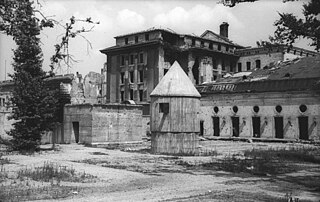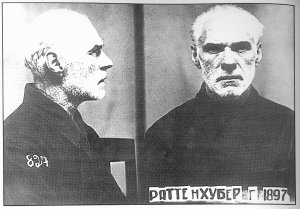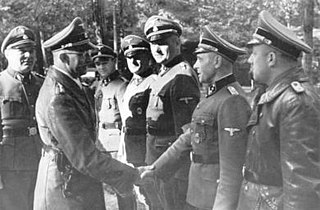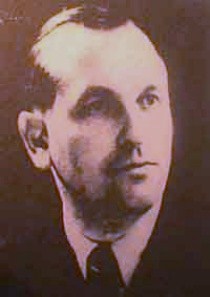
Martin Ludwig Bormann was a German Nazi Party official and head of the Nazi Party Chancellery. He gained immense power by using his position as Adolf Hitler's private secretary to control the flow of information and access to Hitler. He used his position to create an extensive bureaucracy and involve himself as much as possible in the decision making.

The Führerbunker was an air raid shelter located near the Reich Chancellery in Berlin, Germany. It was part of a subterranean bunker complex constructed in two phases in 1936 and 1944. It was the last of the Führer Headquarters (Führerhauptquartiere) used by Adolf Hitler during World War II.

Johanna Maria Magdalena "Magda" Goebbels was the wife of Nazi Germany's Propaganda Minister Joseph Goebbels. A prominent member of the Nazi Party, she was a close ally, companion, and political supporter of Adolf Hitler. Some historians refer to her as the unofficial "first lady" of Nazi Germany, while others give that title to Emmy Göring.

Adolf Hitler was an Austrian-born German politician who was the leader of the Nazi Party, Chancellor of Germany from 1933 to 1945, and Führer ('Leader') of Nazi Germany from 1934 to 1945. He committed suicide by gunshot on 30 April 1945 in his Führerbunker in Berlin. Eva Braun, his wife of one day, committed suicide with him by taking cyanide. In accordance with his prior written and verbal instructions, that afternoon their remains were carried up the stairs through the bunker's emergency exit, doused in petrol, and set alight in the Reich Chancellery garden outside the bunker.

Blondi was Adolf Hitler's German Shepherd, a gift as a puppy from Martin Bormann in 1941. Hitler kept Blondi even after his move into the Führerbunker located underneath the garden of the Reich Chancellery on 16 January 1945.

Heinz Linge was an SS officer who served as a valet for German Fuehrer Adolf Hitler. Linge was present in the Führerbunker on 30 April 1945, when Hitler committed suicide.

Rochus Misch was a German Oberscharführer (sergeant) in the 1st SS Panzer Division Leibstandarte SS Adolf Hitler (LSSAH). He was badly wounded during the Polish campaign during the first month of World War II in Europe. After recovering, from 1940 to April 1945, he served in the Führerbegleitkommando as a bodyguard, courier, and telephone operator for German dictator Adolf Hitler.

Erich Kempka was a member of the SS in Nazi Germany who served as Adolf Hitler's primary chauffeur from 1934 to April 1945. He was present in the area of the Reich Chancellery on 30 April 1945, when Hitler shot himself in the Führerbunker. Kempka delivered the petrol to the garden behind the Reich Chancellery, where the remains of Hitler and Eva Braun were burned.

Gerda Christian, nicknamed "Dara", was one of Adolf Hitler's private secretaries before and during World War II.
Johannes Hentschel was a master electro-mechanic for German dictator Adolf Hitler's apartments in the Old Chancellery. He also served in the same capacity in Hitler's Führerbunker in 1945. He surrendered to Soviet Red Army soldiers on 2 May 1945.

Werner Haase was a professor of medicine and SS member during the Nazi era. He was one of Adolf Hitler's personal physicians. After the war ended, Haase was made a Soviet prisoner of war. He died while in captivity in 1950.

Johann Rattenhuber, also known as Hans Rattenhuber, was a German police and SS general. Rattenhuber was the head of German dictator Adolf Hitler's personal Reichssicherheitsdienst bodyguard from 1933 to 1945. In January 1942, Rattenhuber's RSD units participated in the mass shooting of 227 Jews at Strizhavka. After the war, he was released from Soviet prison on 10 October 1955 and allowed to go to West Germany. He died in Munich in 1957.

Peter Högl was a German officer holding the rank of SS-Obersturmbannführer who was a member of one of Adolf Hitler's bodyguard units. He spent time in the Führerbunker in Berlin at the end of World War II. Högl later died from wounds received during the break-out on 2 May 1945 while crossing the Weidendammer Bridge under heavy fire in Berlin.

Franz Schädle was the last commander of Adolf Hitler's personal bodyguard, from 5 January 1945 until his death on 2 May 1945.

The Vorbunker was an underground concrete structure originally intended to be a temporary air-raid shelter for Adolf Hitler and his guards and servants. It was located behind the large reception hall that was added onto the old Reich Chancellery, in Berlin, Germany, in 1936. The bunker was officially called the "Reich Chancellery Air-Raid Shelter" until 1943, when the complex was expanded with the addition of the Führerbunker, located one level below. On 16 January 1945, Hitler moved into the Führerbunker. He was joined by his senior staff, including Martin Bormann. Later, Eva Braun and Joseph Goebbels moved into the Führerbunker while Magda Goebbels and their six children took residence in the upper Vorbunker. The Goebbels family lived in the Vorbunker until their deaths on 1 May 1945.
Ewald Lindloff was a Waffen-SS officer during World War II, who was present in the Führerbunker on 30 April 1945, when Hitler committed suicide. He was placed in charge of disposing of Hitler's remains. Lindloff was later killed during the break-out on 2 May 1945 while crossing the Weidendammer Bridge under heavy fire in Berlin.

Georg Betz was an SS officer, who rose to the rank of SS-Obersturmbannfuhrer during World War II. Betz served as Adolf Hitler's personal co-pilot and Hans Baur's substitute. Betz was present in the Führerbunker in Berlin in late April 1945. On 1 May 1945, Betz took part in the break-out from the Reich Chancellery in Berlin. Early on 2 May 1945, Betz was wounded and died while crossing the Weidendammer Bridge which was under heavy fire from Soviet troops.
Elena Moiseevna Rzhevskaya was a writer and former Soviet war interpreter. In April and May, 1945, she participated in the Battle of Berlin. According to her memoirs, called in English Memories of a War-time Interpreter, she was a member of the Soviet unit searching for Adolf Hitler in the ruins of the Reich Chancellery. The Führer's corpse was, according to her own words, found by soldier Ivan Churakov on 4 May 1945. Four days later, on 8 May, Colonel Vassily Gorbushin gave her a small box that allegedly contained Hitler's jawbones. During the identification of the corpse, the Soviet team worked in top secret conditions. It consisted of only three people, Rzhevskaya being one of them. She and Gorbushin allegedly managed to find in Berlin, Käthe Heusermann, an assistant of Hugo Blaschke, Hitler's personal dentist. Heusermann confirmed the identity of the Nazi leader. The information was, however, suppressed by Joseph Stalin, who later ordered the facts not to be publicized. She was a recipient of the Andrei Sakharov Prize For Writer's Civic Courage.

Conspiracy theories about Adolf Hitler's death contradict the accepted fact that he committed suicide in the Führerbunker on 30 April 1945. Most of these theories hold that Hitler and his wife, Eva Braun, survived and escaped from Berlin. While these theories have received some exposure in popular culture, these viewpoints are regarded by historians and scientific experts as disproven fringe theories.

The Death of Adolf Hitler: Unknown Documents from Soviet Archives is a 1968 book by Soviet journalist Lev Bezymenski, who served as an interpreter in the Battle of Berlin under Red Army Marshal Georgy Zhukov. The book gives details of the purported Soviet autopsies of Adolf Hitler, Eva Braun, Joseph and Magda Goebbels, their children, and General Hans Krebs. Each of these individuals are recorded as having been subjected to cyanide poisoning. Some of the theories the book presents concerning the death of Hitler have been discredited, including by the author.

















